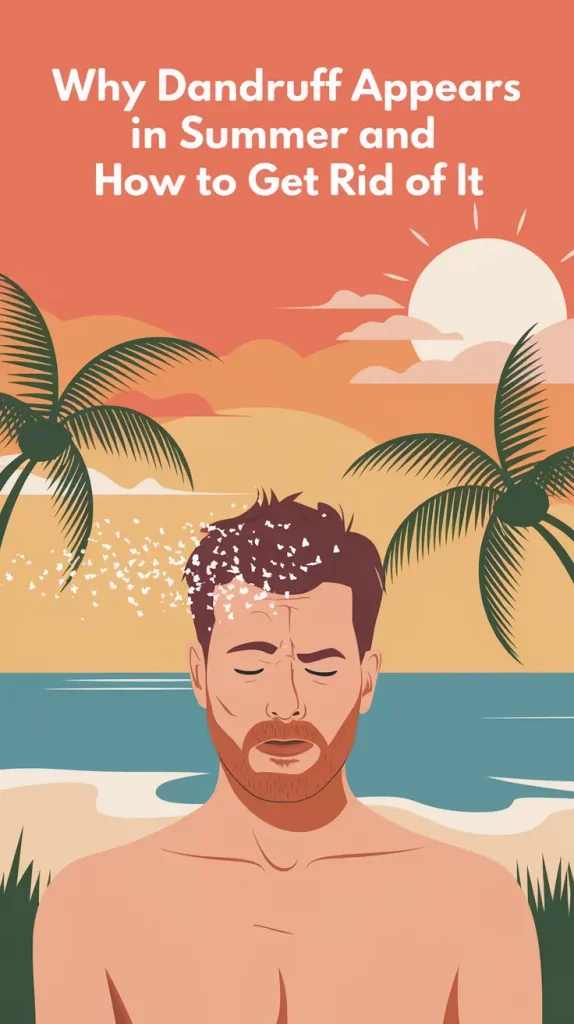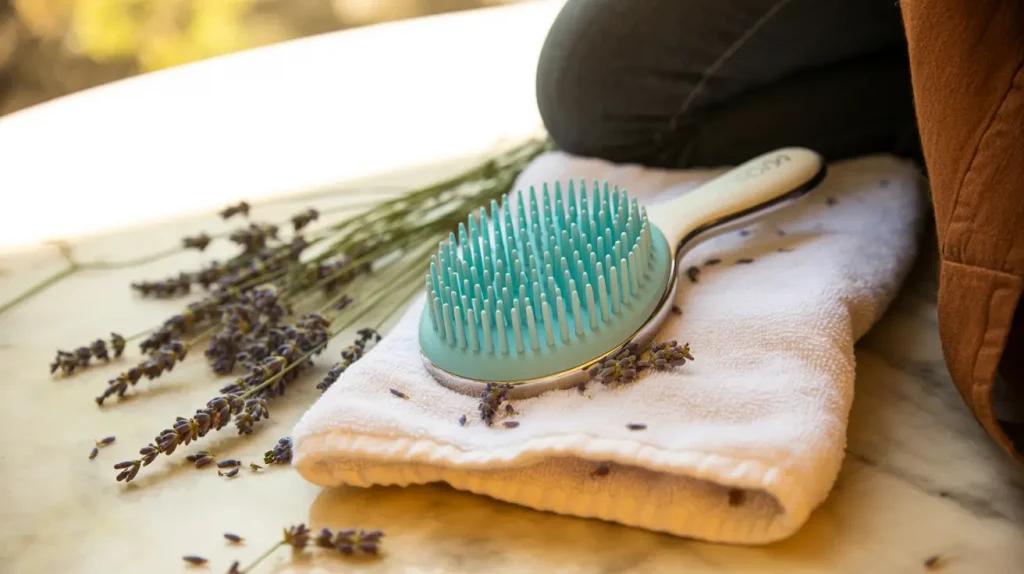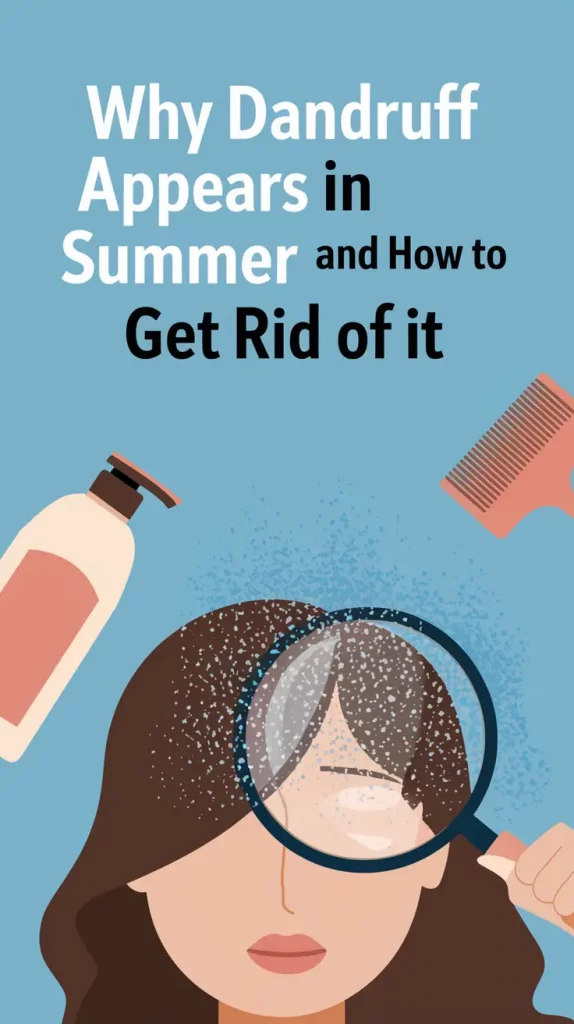Why dandruff appears in summer and how to get rid of it

Did you know that summer heat can actually trigger dandruff, even if you don’t usually suffer from it? If you’re noticing those tiny white flakes every time you touch your hair or wear dark clothing, you’re definitely not alone.
In this article, you’ll learn why dandruff appears in summer, how it behaves differently depending on the weather, and most importantly, how to treat and prevent it effectively in 2025 using science-backed solutions.
Who is this article for?
Whether you’re a beach-goer, fitness enthusiast, city commuter, or just someone tired of an itchy scalp every summer, this article is your complete seasonal guide.
Why Dandruff Gets Worse in Summer

What Changes in the Scalp During Summer?
Your scalp is just like the skin on your face—only it’s more sensitive and often forgotten. Summer introduces a mix of sweat, sun, salt, and pollution, creating the perfect storm for scalp issues:
- Increased sweat leads to clogged hair follicles.
- Higher humidity alters the balance of your scalp’s microbiome.
- UV rays can dry out the skin, prompting more flaking.
Top 5 Reasons You Get Dandruff in Hot Weather
- Sweating and Lack of Proper Cleansing
- Air Conditioning and Dehydration
- Swimming in Chlorinated or Salt Water
- Wearing Hats or Scarves Nonstop
- Wrong Choice of Hair Products
“Are you sure your go-to summer shampoo isn’t making things worse?”
Is It Dry or Oily Dandruff? Understanding the Type Matters
Understanding whether you’re dealing with dry or oily dandruff is the first crucial step toward choosing the right treatment and finally getting relief.
Symptoms and Visual Cues
- Dry Dandruff: Fine, white, falls off easily, accompanied by tight or itchy scalp.
- Oily Dandruff: Larger, yellowish flakes, sticky texture, greasy roots.
Why the Type Affects the Treatment
Using the wrong treatment for your dandruff type can do more harm than good. For example, adding oils to already oily dandruff can worsen inflammation.
| Feature | Dry Dandruff | Oily Dandruff |
|---|---|---|
| Flake Appearance | Small, dry, white flakes | Thick, greasy, yellow flakes |
| Scalp Condition | Tight, dry, possibly itchy | Greasy, itchy, possibly red |
| Common Triggers | Dehydration, sun exposure | Sweat, clogged pores |
7 Common Mistakes That Make Summer Dandruff Worse
- Washing hair with hot water
- Skipping conditioner altogether
- Using harsh shampoos or 2-in-1 formulas
- Leaving chlorine in after swimming
- Trying DIY oil masks without knowing your scalp type
- Overusing dry shampoo
- Ignoring persistent itchiness
“How many of these mistakes are sneaking into your summer routine?”
Step-by-Step: How to Get Rid of Dandruff in Summer
Look for:
- Pyrithione zinc or ketoconazole
- Sulfate-free cleansers
- Natural additives like tea tree oil or aloe vera
Step 2: Focus on the Scalp, Not Just the Hair
- Use a scalp brush or massage tool
- Rinse thoroughly, especially near the crown and nape
- Avoid applying conditioner on the scalp unless it’s formulated for scalp care
Step 3: Weekly Scalp Detox
- Apply gentle exfoliating scrubs or peels 1–2 times a week
- Try apple cider vinegar rinses (diluted!)
- Use a soothing scalp serum after sun exposure
Do Natural Remedies Work? Let’s Debunk a Few Myths
Many natural remedies promise flake-free results, but not all of them are safe or effective—let’s break down which ones actually work.
What Helps and What Doesn’t:
- Apple Cider Vinegar: Helps balance pH but must be diluted.
- Aloe Vera: Excellent for calming irritation.
- Lemon Juice: Often too acidic; can irritate sensitive skin.
- Coconut Oil: Great for dry scalps, but bad for oily dandruff.
| Remedy | Effective? | Notes |
| Apple Cider Vinegar | Yes (diluted) | pH balancing, antimicrobial |
| Aloe Vera Gel | Yes | Soothing, hydrating |
| Lemon Juice | No | May sting or worsen dryness |
| Coconut Oil | Maybe | Only for dry, flaking scalps |
“Ever used lemon juice on your scalp? Time to rethink that!”
What’s New in Dandruff Treatments in 2025?
- Prebiotic & Probiotic Shampoos: Restore microbial balance.
- Scalp Cameras: Help diagnose flake type and density.
- Smart Brushes: Track oil, hydration, and scalp temperature.
- Ingredient Innovations: Adaptogenic herbs, niacinamide, and hyaluronic acid are showing up in new formulas.
Conclusion: No More Flakes This Summer
To wrap it up, let’s recap the must-knows:
- Summer dandruff is common, but manageable.
- Identifying your dandruff type is crucial.
- Your shampoo and scalp routine should change with the seasons.
- Avoid common mistakes like over-washing and poor product choices.
- New treatments in 2025 are smarter and more scalp-focused than ever.
What about you? Have you found a dandruff routine that works in the summer? Share your tips and let’s help others stay flake-free this season!






